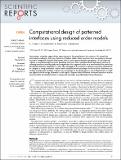Computational design of patterned interfaces using reduced order models
Author(s)
Vattre, Aurelien; Abdolrahim, Niaz; Kolluri, Kedarnath; Demkowicz, Michael J.
DownloadDemkowicz_Computational design.pdf (850.1Kb)
PUBLISHER_CC
Publisher with Creative Commons License
Creative Commons Attribution
Terms of use
Metadata
Show full item recordAbstract
Patterning is a familiar approach for imparting novel functionalities to free surfaces. We extend the patterning paradigm to interfaces between crystalline solids. Many interfaces have non-uniform internal structures comprised of misfit dislocations, which in turn govern interface properties. We develop and validate a computational strategy for designing interfaces with controlled misfit dislocation patterns by tailoring interface crystallography and composition. Our approach relies on a novel method for predicting the internal structure of interfaces: rather than obtaining it from resource-intensive atomistic simulations, we compute it using an efficient reduced order model based on anisotropic elasticity theory. Moreover, our strategy incorporates interface synthesis as a constraint on the design process. As an illustration, we apply our approach to the design of interfaces with rapid, 1-D point defect diffusion. Patterned interfaces may be integrated into the microstructure of composite materials, markedly improving performance.
Date issued
2014-08Department
Massachusetts Institute of Technology. Department of Materials Science and EngineeringJournal
Scientific Reports
Publisher
Nature Publishing Group
Citation
Vattre, A. J., N. Abdolrahim, K. Kolluri, and M. J. Demkowicz. “Computational Design of Patterned Interfaces Using Reduced Order Models.” Sci. Rep. 4 (August 29, 2014): 6231.
Version: Final published version
ISSN
2045-2322